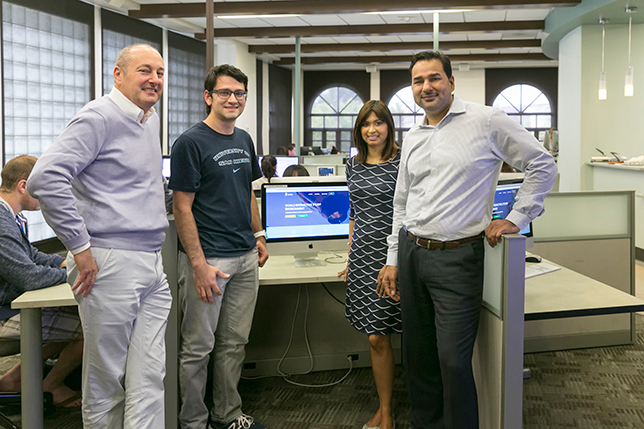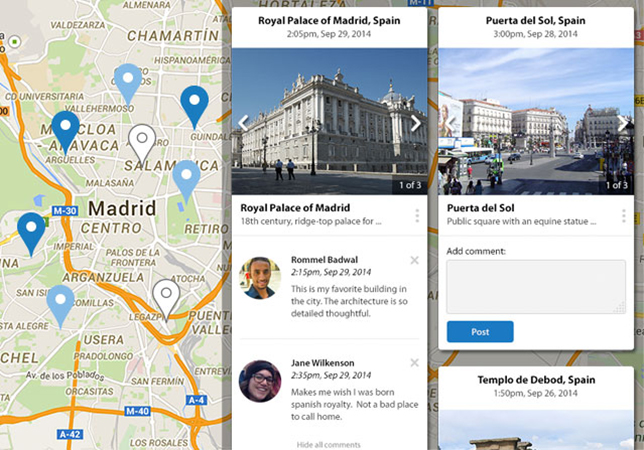Bringing Location-Based Learning to Life
The University of San Diego built a Web-based collaboration tool that connects classroom concepts with real-world locations and discoveries.
Category: Teaching and Learning
Institution: University of San Diego
Project: World Interactive Study Environment
Project leads: Avi Badwal, senior director, ERP Technologies, and Christopher Wessells, vice provost and CIO
Tech vendors/partners: Developed in-house

The University of San Diego's WISE project team (left to right): Chris Wessells, Rommel Rico, Shivani Singh and Avi Badwal (photo courtesy of University of San Diego)
This summer, Derrick Cartwright, director of university galleries at the University of San Diego, is leading a class of 10 students to London to study art history in the city's world-renowned museums. But this is no ordinary trip: The students are pioneering a Web-based tool that uses maps and social media to enhance learning and collaboration.
Developed by USD's IT staff, the WISE (World Interactive Study Environment) platform uses Google's App Engine, Cloud Storage and Maps to allow students and faculty to connect classroom concepts with real-world discoveries. Students can drop a pin on a map, get a street view and begin interactive conversations with each other and their professor by adding comments, photos and videos to other posts, all within the WISE environment.
"We've just had brief training with it, but I think it is a perfect tool for study abroad," Cartwright said. "I plan to have a traditional syllabus for some things, but a lot of what we will be doing will be driven by this social media platform." Students will create visual journals of their experiences at 10 London museums, including their contents, architecture and impact on the culture and economy of London, and display their findings using WISE. "It is exciting," Cartwright said. "My experience has been that the students will teach me about new ways to use this tool."

The WISE platform uses location-based social media tools to bring classroom concepts to life. (photo courtesy of University of San Diego)
Christopher Wessells, vice provost and chief information officer, explained that the initial idea behind WISE was to come up with a way to bolster the university's highly regarded study abroad program, "because we genuinely believe that part of our mission is to educate global citizens. I felt that because the Google mapping platform is so prolific and so easy to use, there must be a way it could be applied to the academic enterprise."
The team that developed the software, led by Avi Badwal, senior director of ERP technologies, realized that the WISE platform could have a profound impact on the way traditional classroom instruction occurs. Instead of sending images and commentary via e-mail or other social platforms, students can take photos and videos with their smartphones, log into WISE, pin the location they visited, upload a photo to that pin, and add their insights and comments. For example, students could visit Shakespeare's home at Stratford-upon-Avon and immediately receive messages from peers, professors or previous students who have posted about their own experiences.
"This can bring the classroom material to life in a lot of ways," Badwal said. "We are enabling faculty members to create database-driven lesson material. Traditionally their material is delivered over a PowerPoint presentation and through a learning management system. We are adding this geo-contextual layer to it." Imagine being at the Sears Tower in Chicago to learn about why it is such an iconic building, he said. You might have learned that in class, but most likely you would have forgotten it by the time you get there. "So what we envision is bringing the educational material to life while students are in that physical space," he explained.
Launched in February 2015, WISE included input from USD faculty members about what information they would like to see and the types of challenges they run into when students are studying abroad. The design team also interviewed students and used them to test out user interface and experience concepts.
What surprised the development team was that interest in the WISE platform extended beyond the study abroad setting. "We find people want to use it here in San Diego," Badwal said. "There is a social science class that looks at low-income neighborhoods and the effects of the digital divide. The students are using maps to plot inequities and other students can comment on those. If there are field trips, the students can post their own images and learning materials."
Another course had students visit the farmers markets in the San Diego area and document their experience, including the fruits and vegetables they find, using WISE. "It is bringing a more social aspect to the classroom material to bring it alive," Badwal said.
Looking ahead, the USD IT team is hoping to get strong feedback from this summer's study abroad students and faculty about how to enhance the application. "Frankly, we view this as something that is only going to improve over time," Wessells said, adding that the team is now working on native Android and iOS versions. Students will be able to take pictures on their smartphones or tablets and upload them directly from the mobile app, as the platform syncs up the geotagging information from the image and the comments.
Wessells also said that the response to the platform has been so positive that the university is studying how it might commercialize WISE. "We are working with general counsel on how we could potentially market this," he said. "It is a closed platform right now. There is a lot of interest on the part of other schools. We are trying to figure out how we would be able to sell this. We haven't made the decision to do that, but it is something we are looking into."
Return to Campus Technology Innovators Awards Home
About the Author
David Raths is a Philadelphia-based freelance writer focused on information technology. He writes regularly for several IT publications, including Healthcare Innovation and Government Technology.